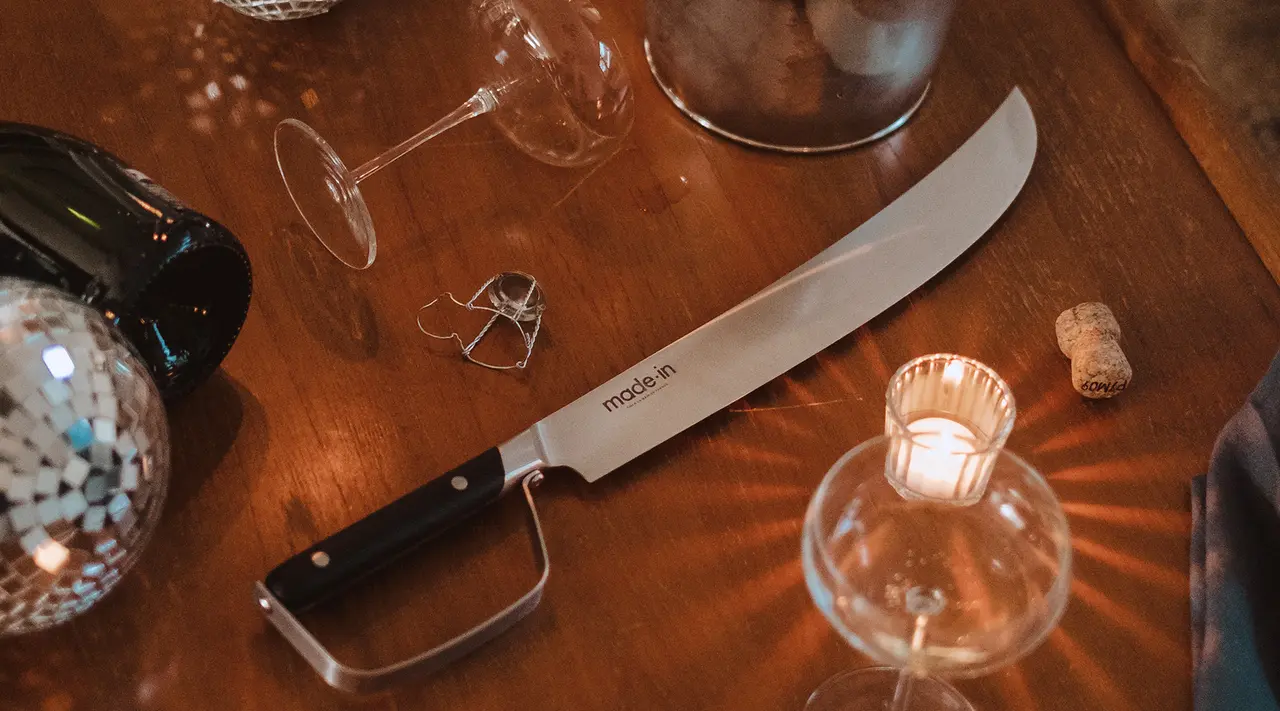“Is sabering necessary?” Sarah Thomas—former Sommelier at Le Bernardin and co-founder of Kalamata’s Kitchen, laughs. “Probably not. But I can’t think of a more fun, celebratory way to open a bottle of champagne, a better gift, or just a more special experience to share with family and friends.”
We spoke with Thomas to create an expert, step-by-step guide to help you saber during safely and effectively with your Champagne Saber.
Step One: Choose The Right Wine

The wine you choose has to be sparkling, but as Thomas notes, “There are all different kinds of sparkling wines.” It’s important to make sure it’s either made in the traditional method, like Champagne, Cremant, or Cava.
“When the bottle is made in the traditional method, the bottle has thicker glass that is less likely to shatter in your hand, and will produce a clean break.” Importantly, Thomas adds that “I don’t recommend sabering with prosecco, ever. The glass is thinner, and there is less pressure in the bottle than traditional method sparkling wines, which makes them more likely to shatter.”
Step Two: Get the Bottle Very Cold
It’s important to only saber with cold bottles, and not just ones straight from your fridge. Thomas recommends fully submerging the bottle in an ice bath and taking extra care to make sure the neck and cork are submerged as well.
“Really cold glass will break more cleanly than a warm bottle,” she says, “and it’s not going to freeze, so you should get it really as cold as you can.” Once removed, don’t delay sabering for too long.
Step Three: Wipe it Well
Once you take the bottle out of the ice bath, “it’s important to wipe it down really well,” Thomas says, “otherwise, it might slip out of your hand.” Remember, it’s still a bottle of champagne, so do this gently, as any shaking will create more carbonation.
Step Four: Find the Seam
After removing the wrapping from about the shoulder of the bottle to the neck, locate the seam in the glass and where it meets the neck of the bottle. “This is the weakest point of the bottle,” Thomas says, “and where your saber is going to run.” She says that “Your goal is to hit where the lip meets the seam, near the top of the bottle.”
Remember: you’re not cutting through the glass, but instead adding exterior pressure to the lip of the bottle and letting the carbonation inside do the rest.
Step Five: Hold the Bottle
“You want to hold the bottle at a 30 to 45-degree angle, in your non-dominant hand,” Thomas says. Adding that you should “point the corked side away from any people, breakable objects, or walls nearby” —you don’t want the cork to ricochet.
Step Six: Remove the Cage
At this point, the wire cage should still be on the bottle covering the cork. “Once you take the cage off, it’s live ammo,” Thomas says. But now is the time to remove it. “Do so slowly, keeping the bottle still facing away from you, and pray the cork doesn’t pop off,” she says.
Step Seven: Take a Few Practice Swings
Take your saber in your dominant hand and lay it flat against the bottle. Hold it flat and using the blunt edge, slowly run the saber along the seam of the bottle from the shoulder to the lip. “You can take a few practice strokes, running it back and forth to make yourself feel better.”
Step Eight: Saber Away
In one semi-forceful tap, follow the seam up to where it meets the neck of the bottle. Follow through with your hand and voila—the cork and the ring of glass holding it will fly off, and the pressure in the bottle will result in a clean break, allowing you to serve the Champagne into nearby glasses.
Ready to Saber?
If you're ready to show off your sabering skills, then it's time to do it right with a French-made Saber. Impress your guests (and yourself) at your next celebration with a proper Champagne Saber, now available for engraving with special names or dates.

























